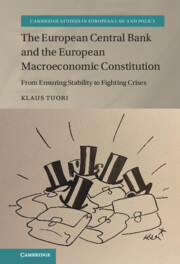 The European Central Bank and the European Macroeconomic Constitution
The European Central Bank and the European Macroeconomic Constitution from Part III - The ECB from a Central Bank of Stability to a Central Bank of Crisis
Published online by Cambridge University Press: 15 September 2022
Things have not gone as planned. The EMU and the ECB as its guardian were assumed to guarantee stability and prosperity for the euro area, but the reality has been anything but. Consequently, the ECB is a very different creature today from what it started off as – or indeed what is should be on the basis of the European Macroeconomic Constitution. Most changes have taken place as reactions to new and unforeseen situations, and could be defended on economic grounds, if not always on the grounds that were presented by the ECB itself. Unsurprisingly, the ECB has described the measures it has adopted as successes, which follows a long history in central banking of claiming successes and never admitting mistakes. However, in order to sketch ways forward, it is first necessary look at where are now and what are the main constitutional problems at hand. A broad economic and constitutional assessment reveals two main interrelated imbalances. First, the increasingly discretionary reach of the ECB and its constitutional model of a narrow central bank, which also relates to the aim to control the ECB through constitutional objectives that are becoming increasingly vague. Second, the increasingly political scope of the whole European Macroeconomic Constitution on one hand and the reliance on the ECB as its main guardian on the other hand, has led to a serious overburdening of monetary policy.
To save this book to your Kindle, first ensure [email protected] is added to your Approved Personal Document E-mail List under your Personal Document Settings on the Manage Your Content and Devices page of your Amazon account. Then enter the ‘name’ part of your Kindle email address below. Find out more about saving to your Kindle.
Note you can select to save to either the @free.kindle.com or @kindle.com variations. ‘@free.kindle.com’ emails are free but can only be saved to your device when it is connected to wi-fi. ‘@kindle.com’ emails can be delivered even when you are not connected to wi-fi, but note that service fees apply.
Find out more about the Kindle Personal Document Service.
To save content items to your account, please confirm that you agree to abide by our usage policies. If this is the first time you use this feature, you will be asked to authorise Cambridge Core to connect with your account. Find out more about saving content to Dropbox.
To save content items to your account, please confirm that you agree to abide by our usage policies. If this is the first time you use this feature, you will be asked to authorise Cambridge Core to connect with your account. Find out more about saving content to Google Drive.